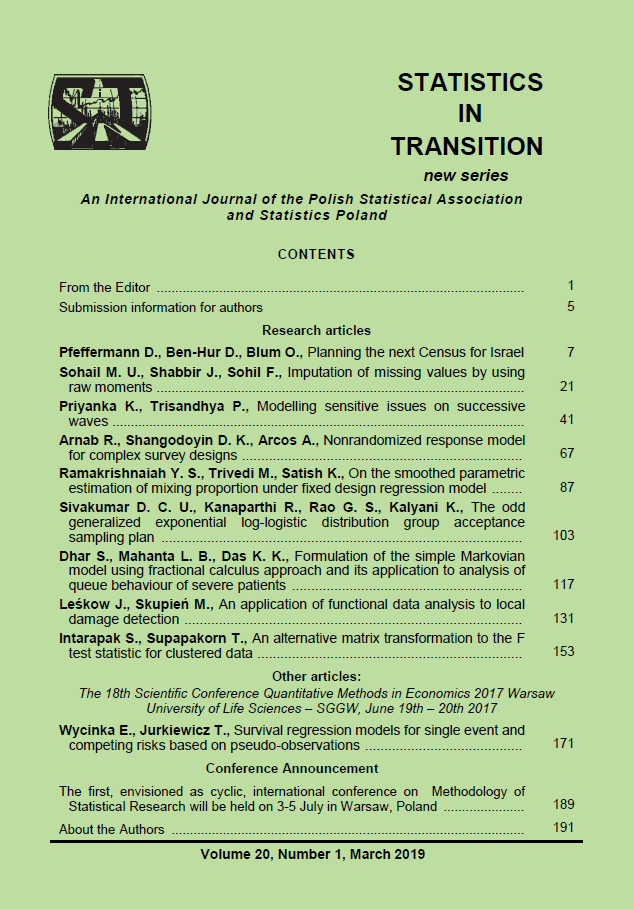ARTICLE
ABSTRACT
The estimation of population parameters might be quite laborious and inefficient, when the sample data have missing values. In comparison follow-up visits, the method of imputation has been found to be a cheaper procedure from a cost point of view. In the present study, we can enhance the performance of imputation procedures by utilizing the raw moments of the auxiliary information rather than their ranks, especially, when the ranking of the auxiliary variable is expensive or difficult to do so. Equations for bias and mean squared error are obtained by large sample approximation. Through the numerical and simulation studies it can be easily understood that the proposed method of imputation can outperform their counterparts.
KEYWORDS
non-response, imputation, raw moments, relative efficiency
REFERENCES
AHMED, M., AL-TITI, O., AL-RAWI, Z., ABU-DAYYEH, W., (2006). Estimation of a population mean using different imputation methods. Statistics in Transition 7 (6), pp. 1247–1264.
BAHL, S., TUTEJA, R., (1991). Ratio and product type exponential estimators. Journal of Information and Optimization Sciences, 12 (1), pp. 159–164.
COCHRAN, W., (1940). The estimation of the yields of cereal experiments by sampling for the ratio of grain to total produce. The Journal of Agricultural Science, 30 (2), pp. 262–275.
GROVER, L. K., KAUR, P., (2014). A generalized class of ratio type exponential estimators of population mean under linear transformation of auxiliary variable. Communications in Statistics-Simulation and Computation, 43 (7), pp. 1552– 1574.
HAQ, A., KHAN, M., HUSSAIN, Z., (2017). A new estimator of finite population mean based on the dual use of the auxiliary information. Communications in Statistics-Theory and Methods, 46 (9), pp. 4425–4436.
HEITJAN, D. F., BASU, S., (1996). Distinguishing "missing at random" and "missing completely at random". The American Statistician, 50 (3), pp. 207–213.
HERRERA, C. N. B., AL-OMARI, A. I., (2011). Ranked set estimation with imputation of the missing observations: the median estimator. Revista Investigacion Operacional, 32 (1), pp. 30–37.
JAMES, G., WITTEN, D., HASTIE, T., AND TIBSHIRANI, R., (2013). An introduction to statistical learning, Vol. 6, Springer.
LITTLE, R. J., RUBIN, D. B., (2014). Statistical analysis with missing data. John WileySons.
MOHAMED, C., SEDORY, S. A., SINGH, S., (2016). Imputation using higher order moments of an auxiliary variable. Communications in Statistics-Simulation and Computation, (just-accepted), pp. 00–00.
RAO, T., (1991). On certain methods of improving ration and regression estimators. Communications in Statistics-Theory and Methods, 20 (10), pp. 3325–3340.
RUBIN, D. B., (1976). Inference and missing data. Biometrika, 63 (3), pp. 581–592.
SINGH, S., (2003). Advanced Sampling Theory With Applications: How Michael Selected Amy, Vol. 2, Springer ScienceBusiness Media.
SOHAIL, M. U., SHABBIR, J., AHMED, S., (2017). Modified class of ratio and regression type estimators for imputing scrambling response, Pakistan, Journal of Statistics, 33 (4), pp. 277–300.
